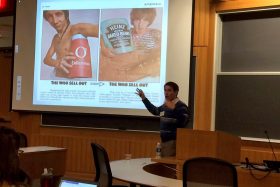The Legal Method and Communication Fellow at Elon Law shared details of his ongoing research into copyright law based on a legal dispute between The Who and a U.S. company that took issue with the British rock band's 1967 album "The Who Sell Out."

The February colloquium brought together scholars from around the world to discuss intellectual property law, providing them with an opportunity to present academic works-in-progress for early feedback.
McFarlin’s experience prior to joining Elon Law includes teaching constitutional law, employment law and mock trial courses as an adjunct professor at Washington University in St. Louis and Fontbonne University, and practicing business litigation in the St. Louis metropolitan area. His interests and experiences center on intellectual property law, particularly the areas of copyright and trademark.
McFarlin’s abstract:
The seminal rock group The Who designed their 1967 album “The Who Sell Out” as both an homage to the “pirate” radio stations, which the British government had recently banned, and a satire of the consumer culture promoted on those stations. In order to simulate a pirate radio station broadcast, The Who interspersed without permission a number of authentic pirate radio jingles among their own original songs. These jingles were created by the U.S.-based company PAMS, Inc., which had licensed them to the pirates but retained ownership of the copyrights. PAMS threatened to sue the Who, and the parties settled, permitting “The Who Sell Out”’s continued distribution.
This Article contemplates what would have happened had the dispute gone to trial and, more expansively, explores what lessons we can take from “The Who Sell Out” for fair use in copyright. In particular, under what circumstances and to what extent should homage constitute fair use? And because the Who’s homage was not to (or not just to) the jingles themselves but to the pirate radio stations on which the jingles aired, to what extent is homage to something related to the copied work, but not the copied work itself, fair use? Further, how do we distinguish the Who’s homage from parody, and perhaps more importantly, should we distinguish the two for purposes of fair use? And when homage is paired with satire—two types of commentary not necessarily considered fair use on their own—should we consider them fair use when combined?
In this way, the story of the concept album “The Who Sell Out” may provide new insights into how we distinguish among homage, parody, and satire in copyright, as well as under what circumstances these various modes of art will constitute fair use.


